This article was co-authored by Mark Co, DPM. Dr. Mark Co is a Podiatrist who runs his own private practice in San Francisco, California. Dr. Co specializes in treatments for bunions, ingrown toenails, toenail fungus, warts, plantar fasciitis and other causes of foot pain. He also offers custom orthotics for the treatment and prevention of foot and ankle issues. Dr. Co completed a Master of Business Administration (MBA) at New York University and an MA in Electrical Engineering and Computer Science at Johns Hopkins University. Dr. Co also completed his DPM at the California School of Podiatric Medicine and a residency and internship at the Kaiser Permanente Medical Center, Santa Clara, California. Dr. Co was awarded San Francisco's "Top 3 Podiatrists" in 2018, 2019, and 2020. Dr. Co is also a member of the CPMA (American Podiatric Medical Association).
There are 10 references cited in this article, which can be found at the bottom of the page.
wikiHow marks an article as reader-approved once it receives enough positive feedback. In this case, 87% of readers who voted found the article helpful, earning it our reader-approved status.
This article has been viewed 982,073 times.
A corn or callus is an area of thick, hardened, dead skin, caused by friction and irritation. Corns form on the sides and tops of the toes, and can be quite painful. A callus typically forms on the bottom or sides of the feet and can be uncomfortable and unsightly, but does not usually become painful. Calluses can also form on the hands. Corns and calluses can typically be treated at home, but if yours are painful, persistent, or if you have an underlying medical condition, such as diabetes, medical treatment may be necessary.
Steps
Treating Corns and Calluses at Home
-
1Differentiate between a corn and a callus. Corns and calluses are not the same thing, therefore the treatment approaches are different.[1]
- A corn can develop between the toes, has a core, and can be quite painful. Corns also develop along the tops of the toes, most often located just above a joint in the toe.[2]
- Corns are categorized as hard, soft, or periungual. A hard corn most commonly develops on the top of the toe and over a bone joint. A soft corn develops between the toes, usually between the fourth and fifth toes. A periungual corn is less common, and occurs along the edge of a nailbed.[3]
- A core is not always present, but is usually found at the center of the corn. The core consists of thick and dense skin tissue.[4]
- The core of the corn points inward and often presses on a bone or nerve which causes it to be quite painful.[5]
- A callus does not have a core, and is a broader area that is made of evenly distributed thicker tissue. Calluses are not usually painful, although they can be uncomfortable.[6]
- Calluses usually develop on the bottom of the foot and just beneath the toe area. Calluses can also develop on the hands, usually on the palm side and just under the fingers.[7]
- Both corns and calluses are caused by friction and pressure.[8]
-
2Use over-the-counter remedies. Salicylic acid is the most common ingredient found in over-the-counter products used to treat corns and calluses.[9]Advertisement
-
3Apply salicylic acid pads to remove a corn. Salicylic acid corn remover pads are available without prescription in strengths as strong as 40%.[12]
- Soak the foot in warm water for about five minutes to soften the tissue. Dry the foot and toes thoroughly before applying the pads.[13]
- Take care not to apply the pad against healthy skin tissue.[14]
- Most products recommend repeating the procedure every 48 to 72 hours, for up to 14 days, or until the corn is removed.[15]
- Salicylic acid is classed as a keratolytic agent. This means it helps to bring added moisture to the area while working to soften and dissolve skin tissue. Salicylic acid can be harmful to healthy tissue.[16]
- Follow the instructions on the product or in the product literature. Do not use if you are allergic to salicylic acid products.[17]
- Avoid getting salicylic acid products in your eyes, nose, or mouth, and do not use on any other area of the body without instructions from your doctor.[18]
- Rinse any areas accidentally exposed to salicylic acid with water immediately.[19]
- Keep salicylic acid products stored in a safe manner, away from children and pets.
-
4Use salicylic acid for calluses. Salicylic acid comes in a variety of forms and a multitude of strengths. Foams, lotions, gels, and pads are available that can be used to treat callused areas on your foot.[20]
- Each product has unique application instructions. Follow the direction on the product or in the product literature to effectively use salicylic acid products to get rid of calluses.[21]
-
5Use topical products with 45% urea. Other than treatment with salicylic acid, other products are available over-the-counter that may be helpful.[22]
- Products that contain 45% urea can be used topically as keratolytics to help soften and remove unwanted tissue, including corns and calluses.[23]
- Follow the directions provided on the product label or contained in the product literature.[24]
- Routine directions for using 45% topical urea products include twice daily applications until the condition has resolved.[25]
- Do not ingest topical urea products, and do not get them in your eyes, nose, or mouth.[26]
- Keep the products away from children and pets.[27]
- If swallowed, call 911, call a poison control center, or seek emergency medical attention the fastest way possible.[28]
-
6Use a pumice stone. For callused areas, using a pumice stone or file designed for the foot, can help to get rid of the hardened areas of skin.[29] They're especially helpful on broad, callused areas, like the heel or the bottom of your feet.[30]
- This can also be used for unwanted calluses that form on the hands.[31]
- Using a device like a pumice stone or file helps to remove layers of dead skin. Take care not to file away healthy tissue. Doing so can lead to further irritation and possibly infection if the healthy skin is broken.[32]
- File away layers of thickened and hard tissue before you apply medication.[33]
-
7Soak your feet. Soaking your feet in warm water helps to soften the thickened areas of tissue for both corns and calluses.[34]
- For unwanted calluses on your hands, soaking the area can help to soften the tissue just as it does for your feet.[35]
- Dry your feet or hands thoroughly after soaking. While your skin tissue is soft after soaking, proceed with using your pumice stone or file.[36] .
- Even if you don’t have time to soak your feet or hands every day, use the pumice stone or file just after getting out of your bath or shower.[37]
-
8Keep your skin moist. Apply moisturizers to your feet and hands to help keep the tissues soft.[38]
Seeking Medical Attention
-
1Pursue medical help in treating the condition. If you have a callus or corn that's deeply seated in one area, it's probably best to have that treated at a podiatrist's office. Also, if you have diabetes, you are at greater risk of serious foot problems partly caused by changes in circulation to your extremities, so it's especially important to see a doctor.[41]
- Medical conditions like diabetes, peripheral neuropathy, and any other condition that interferes with normal blood flow, warrant medical help to treat corns and calluses. Talk to your doctor before treating your corns or calluses at home.[42]
-
2Ask your doctor for instructions if the areas are large and painful. While corns and calluses rarely fall in the category of a medical emergency, sometimes the areas are very large and quite painful.[43]
- Seeking help from your doctor is the safest and most effective way to proceed with treatment.[44]
- Some corns and calluses are resistant to the available over-the-counter treatment options. Ask your doctor about prescription strength products or procedures that may be helpful.[45]
- Your doctor can help by performing some in-office procedures to improve the condition.[46]
- Using a scalpel or other tool available in the medical office, your doctor can help to trim away large areas of excess and hardened skin.[47]
- Do not attempt to trim very thick areas of hardened skin at home. This may lead to more irritation, bleeding, and possible infection.[48]
-
3
-
4
-
5Consider foot conditions that cause misalignment. Some people have deformities in their feet that cause them to have repeated problems, including recurrent problems with corns and calluses.[53]
- Your doctor may refer you to a podiatrist for treatment. Some conditions that may be contributing to the problems you are having with corns and calluses include hammer toe, bone spurs, lower than normal natural arches, and bunions.[54]
- Many of these conditions can be corrected by wearing inserts or specially designed footwear.[55]
- In rare cases, surgery may be warranted.[56]
-
6Watch for complications on your hands. When calluses develop from a source of friction or pressure on your hands, it is possible for the skin to break and an infection can begin.[57]
- In some cases, blisters form along with, just beneath, or beside the calluses. When this happens, fluid is contained inside the blisters, which is naturally absorbed back into the skin with time. If the blisters pop or drain, it is easy to get an infection started in the healthy tissue around the blisters and calluses.[58]
- Contact your doctor if your hand appears reddened, swollen, or warm to the touch.[59]
- Topical or systemic antibiotics may be needed if you have an infection.[60]
Preventing Future Problems
-
1
-
2Wear shoes that fit properly. Shoes that do not fit can rub against your toes or cause your foot to slide inside the shoe.[63]
- Be sure your toes have plenty of wiggle room inside your shoes.[64]
- Corns develop along the tops and sides of your toes, and can be due to wearing shoes that do not give your toes enough room.[65]
- Repeated rubbing or irritation caused by shoes that do not fit properly are a major cause of corns of calluses.[66]
- Tightly fitting shoes and shoes with high heels that cause your fit to slide forward can cause corns and calluses to develop.[67]
- Calluses develop when the bottom or side of the foot slides against a part of the shoe that is irritating, or slides inside of shoes that are too large.[68]
-
3Wear socks. Going without socks can cause your feet to experience friction and pressure from your shoes.[69]
- Always wear socks to prevent the friction and pressure. Especially in shoes that are designed to wear socks, such as athletic foot wear, heavy work shoes, and boots.[70]
- Be sure your socks fit properly. Socks that are too tight can squeeze your toes causing unwanted pressure and friction. Loosely fitting socks can slide down on your foot while in the shoe and contribute to added friction and pressure on areas of your foot.[71]
-
4Apply protective coverings. Use pads placed on top of the areas where the corns develop, between your toes, or along areas where the calluses form.[72]
- Using pads, sections lamb’s wool, or toe separators can help to reduce the friction and pressure along your toe or foot area where the corns and calluses are located.[73]
-
5Wear gloves. Calluses form on your hands at the areas of greatest friction.[74]
- In many cases, calluses on the hand are welcomed. One example involves people that play musical instruments. Guitar players, for instance, appreciate the calluses that form on the tips of their fingers. This helps them to play their instrument without pain.[75]
- Another example is athletes that lift weights. The calluses that form on their hands can help them to grasp and manipulate the bars used in weight lifting.[76]
Expert Q&A
Did you know you can get expert answers for this article?
Unlock expert answers by supporting wikiHow
-
QuestionHow do podiatrists remove corns?
 Mark Co, DPMDr. Mark Co is a Podiatrist who runs his own private practice in San Francisco, California. Dr. Co specializes in treatments for bunions, ingrown toenails, toenail fungus, warts, plantar fasciitis and other causes of foot pain. He also offers custom orthotics for the treatment and prevention of foot and ankle issues. Dr. Co completed a Master of Business Administration (MBA) at New York University and an MA in Electrical Engineering and Computer Science at Johns Hopkins University. Dr. Co also completed his DPM at the California School of Podiatric Medicine and a residency and internship at the Kaiser Permanente Medical Center, Santa Clara, California. Dr. Co was awarded San Francisco's "Top 3 Podiatrists" in 2018, 2019, and 2020. Dr. Co is also a member of the CPMA (American Podiatric Medical Association).
Mark Co, DPMDr. Mark Co is a Podiatrist who runs his own private practice in San Francisco, California. Dr. Co specializes in treatments for bunions, ingrown toenails, toenail fungus, warts, plantar fasciitis and other causes of foot pain. He also offers custom orthotics for the treatment and prevention of foot and ankle issues. Dr. Co completed a Master of Business Administration (MBA) at New York University and an MA in Electrical Engineering and Computer Science at Johns Hopkins University. Dr. Co also completed his DPM at the California School of Podiatric Medicine and a residency and internship at the Kaiser Permanente Medical Center, Santa Clara, California. Dr. Co was awarded San Francisco's "Top 3 Podiatrists" in 2018, 2019, and 2020. Dr. Co is also a member of the CPMA (American Podiatric Medical Association).
Podiatrist
-
QuestionMost remedies of applying a corn plaster state something along the lines of "apply until the corn is removed," or "apply until the corn is easily removed." In neither case does it state how to remove it easily or what to look for to know a corn is ready to be removed.
 Chris M. Matsko, MDDr. Chris M. Matsko is a retired physician based in Pittsburgh, Pennsylvania. With over 25 years of medical research experience, Dr. Matsko was awarded the Pittsburgh Cornell University Leadership Award for Excellence. He holds a BS in Nutritional Science from Cornell University and an MD from the Temple University School of Medicine in 2007. Dr. Matsko earned a Research Writing Certification from the American Medical Writers Association (AMWA) in 2016 and a Medical Writing & Editing Certification from the University of Chicago in 2017.
Chris M. Matsko, MDDr. Chris M. Matsko is a retired physician based in Pittsburgh, Pennsylvania. With over 25 years of medical research experience, Dr. Matsko was awarded the Pittsburgh Cornell University Leadership Award for Excellence. He holds a BS in Nutritional Science from Cornell University and an MD from the Temple University School of Medicine in 2007. Dr. Matsko earned a Research Writing Certification from the American Medical Writers Association (AMWA) in 2016 and a Medical Writing & Editing Certification from the University of Chicago in 2017.
Family Medicine Physician You can use a pumice stone to remove a corn after treatment. Check out: How to Use a Pumice Stone.
You can use a pumice stone to remove a corn after treatment. Check out: How to Use a Pumice Stone. -
QuestionI have lymphedema in my legs and feet. Is it ok to treat a corn myself?
 Chris M. Matsko, MDDr. Chris M. Matsko is a retired physician based in Pittsburgh, Pennsylvania. With over 25 years of medical research experience, Dr. Matsko was awarded the Pittsburgh Cornell University Leadership Award for Excellence. He holds a BS in Nutritional Science from Cornell University and an MD from the Temple University School of Medicine in 2007. Dr. Matsko earned a Research Writing Certification from the American Medical Writers Association (AMWA) in 2016 and a Medical Writing & Editing Certification from the University of Chicago in 2017.
Chris M. Matsko, MDDr. Chris M. Matsko is a retired physician based in Pittsburgh, Pennsylvania. With over 25 years of medical research experience, Dr. Matsko was awarded the Pittsburgh Cornell University Leadership Award for Excellence. He holds a BS in Nutritional Science from Cornell University and an MD from the Temple University School of Medicine in 2007. Dr. Matsko earned a Research Writing Certification from the American Medical Writers Association (AMWA) in 2016 and a Medical Writing & Editing Certification from the University of Chicago in 2017.
Family Medicine Physician
References
- ↑ http://emedicine.medscape.com/article/1089807-overview
- ↑ http://emedicine.medscape.com/article/1089807-overview
- ↑ http://emedicine.medscape.com/article/1089807-overview
- ↑ http://emedicine.medscape.com/article/1089807-overview
- ↑ http://www.skinsight.com/adult/cornClavus.htm
- ↑ http://emedicine.medscape.com/article/1089807-overview
- ↑ http://emedicine.medscape.com/article/1089807-overview
- ↑ http://www.nlm.nih.gov/medlineplus/ency/article/001232.htm
- ↑ http://www.mayoclinic.org/diseases-conditions/corns-and-calluses/basics/definition/con-20014462
- ↑ http://www.mayoclinic.org/diseases-conditions/corns-and-calluses/basics/definition/con-20014462
- ↑ http://www.mayoclinic.org/diseases-conditions/corns-and-calluses/basics/definition/con-20014462
- ↑ https://www.drugs.com/condition/c.html
- ↑ https://www.drugs.com/condition/c.html
- ↑ https://www.drugs.com/condition/c.html
- ↑ https://www.drugs.com/condition/c.html
- ↑ https://www.drugs.com/condition/c.html
- ↑ https://www.drugs.com/condition/c.html
- ↑ http://www.mayoclinic.org/drugs-supplements/salicylic-acid-topical-route/description/drg-20066030
- ↑ http://www.mayoclinic.org/drugs-supplements/salicylic-acid-topical-route/description/drg-20066030
- ↑ http://www.drugs.com/mtm/dr-scholl-s-callus-removers.html
- ↑ http://www.drugs.com/mtm/dr-scholl-s-callus-removers.html
- ↑ http://www.drugs.com/pro/urea-45-cream.html
- ↑ http://www.drugs.com/pro/urea-45-cream.html
- ↑ http://www.drugs.com/pro/urea-45-cream.html
- ↑ http://www.drugs.com/pro/urea-45-cream.html
- ↑ http://www.drugs.com/pro/urea-45-cream.html
- ↑ http://www.drugs.com/pro/urea-45-cream.html
- ↑ http://www.drugs.com/pro/urea-45-cream.html
- ↑ http://www.mayoclinic.org/diseases-conditions/corns-and-calluses/basics/definition/con-20014462
- ↑ Mark Co, DPM. Podiatrist. Expert Interview. 21 April 2020.
- ↑ http://www.mayoclinic.org/diseases-conditions/corns-and-calluses/basics/definition/con-20014462
- ↑ http://www.mayoclinic.org/diseases-conditions/corns-and-calluses/basics/definition/con-20014462
- ↑ http://www.mayoclinic.org/diseases-conditions/corns-and-calluses/basics/definition/con-20014462
- ↑ http://www.mayoclinic.org/diseases-conditions/corns-and-calluses/basics/definition/con-20014462
- ↑ http://www.mayoclinic.org/diseases-conditions/corns-and-calluses/basics/definition/con-20014462
- ↑ http://www.mayoclinic.org/diseases-conditions/corns-and-calluses/basics/definition/con-20014462
- ↑ http://www.mayoclinic.org/diseases-conditions/corns-and-calluses/basics/definition/con-20014462
- ↑ http://www.mayoclinic.org/diseases-conditions/corns-and-calluses/basics/definition/con-20014462
- ↑ http://www.mayoclinic.org/diseases-conditions/corns-and-calluses/basics/definition/con-20014462
- ↑ Mark Co, DPM. Podiatrist. Expert Interview. 21 April 2020.
- ↑ http://familydoctor.org/familydoctor/en/health-tools/search-by-symptom/foot-problems.printerview.all.html
- ↑ http://www.mayoclinic.org/diseases-conditions/corns-and-calluses/basics/definition/con-20014462
- ↑ http://familydoctor.org/familydoctor/en/health-tools/search-by-symptom/foot-problems.printerview.all.html
- ↑ http://familydoctor.org/familydoctor/en/health-tools/search-by-symptom/foot-problems.printerview.all.html
- ↑ http://familydoctor.org/familydoctor/en/health-tools/search-by-symptom/foot-problems.printerview.all.html
- ↑ http://familydoctor.org/familydoctor/en/health-tools/search-by-symptom/foot-problems.printerview.all.html
- ↑ http://www.mayoclinic.org/diseases-conditions/corns-and-calluses/basics/definition/con-20014462
- ↑ http://www.mayoclinic.org/diseases-conditions/corns-and-calluses/basics/definition/con-20014462
- ↑ http://familydoctor.org/familydoctor/en/health-tools/search-by-symptom/foot-problems.printerview.all.html
- ↑ http://familydoctor.org/familydoctor/en/health-tools/search-by-symptom/foot-problems.printerview.all.html
- ↑ http://familydoctor.org/familydoctor/en/health-tools/search-by-symptom/foot-problems.printerview.all.html
- ↑ http://familydoctor.org/familydoctor/en/health-tools/search-by-symptom/foot-problems.printerview.all.html
- ↑ http://www.mayoclinic.org/diseases-conditions/corns-and-calluses/basics/definition/con-20014462
- ↑ http://www.mayoclinic.org/diseases-conditions/corns-and-calluses/basics/definition/con-20014462
- ↑ http://www.mayoclinic.org/diseases-conditions/corns-and-calluses/basics/definition/con-20014462
- ↑ http://www.mayoclinic.org/diseases-conditions/corns-and-calluses/basics/definition/con-20014462
- ↑ http://www.mayoclinic.org/diseases-conditions/corns-and-calluses/basics/definition/con-20014462
- ↑ http://www.mayoclinic.org/diseases-conditions/corns-and-calluses/basics/definition/con-20014462
- ↑ http://www.mayoclinic.org/diseases-conditions/corns-and-calluses/basics/definition/con-20014462
- ↑ http://www.mayoclinic.org/diseases-conditions/corns-and-calluses/basics/definition/con-20014462
- ↑ http://www.mayoclinic.org/diseases-conditions/corns-and-calluses/basics/definition/con-20014462
- ↑ http://www.mayoclinic.org/diseases-conditions/corns-and-calluses/basics/definition/con-20014462
- ↑ http://www.mayoclinic.org/diseases-conditions/corns-and-calluses/basics/definition/con-20014462
- ↑ http://www.mayoclinic.org/diseases-conditions/corns-and-calluses/basics/definition/con-20014462
- ↑ http://www.mayoclinic.org/diseases-conditions/corns-and-calluses/basics/definition/con-20014462
- ↑ http://www.mayoclinic.org/diseases-conditions/corns-and-calluses/basics/definition/con-20014462
- ↑ http://www.mayoclinic.org/diseases-conditions/corns-and-calluses/basics/definition/con-20014462
- ↑ http://www.mayoclinic.org/diseases-conditions/corns-and-calluses/basics/definition/con-20014462
- ↑ http://www.mayoclinic.org/diseases-conditions/corns-and-calluses/basics/definition/con-20014462
- ↑ http://www.mayoclinic.org/diseases-conditions/corns-and-calluses/basics/definition/con-20014462
- ↑ http://www.mayoclinic.org/diseases-conditions/corns-and-calluses/basics/definition/con-20014462
- ↑ http://www.mayoclinic.org/diseases-conditions/corns-and-calluses/basics/definition/con-20014462
- ↑ http://www.mayoclinic.org/diseases-conditions/corns-and-calluses/basics/definition/con-20014462
- ↑ http://www.mayoclinic.org/diseases-conditions/corns-and-calluses/basics/definition/con-20014462
- ↑ http://www.mayoclinic.org/diseases-conditions/corns-and-calluses/basics/definition/con-20014462
- ↑ http://www.mayoclinic.org/diseases-conditions/corns-and-calluses/basics/definition/con-20014462
About This Article
To treat a corn or a callus, start by soaking your feet in warm water to soften the thickened areas of skin. Then, use a pumice stone to file away the layers of dead skin. When you’re finished, apply a moisturizer to callused areas to keep them soft and prevent more calluses from forming. For a more severe corn with a core at the center, apply a salicylic corn pad to the area and leave it on for 48 hours. For tips from our Medical reviewer on preventing corns and calluses in the future, keep reading.
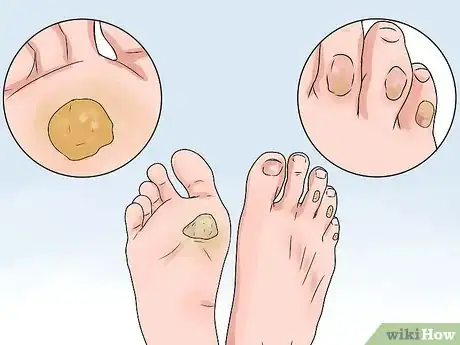
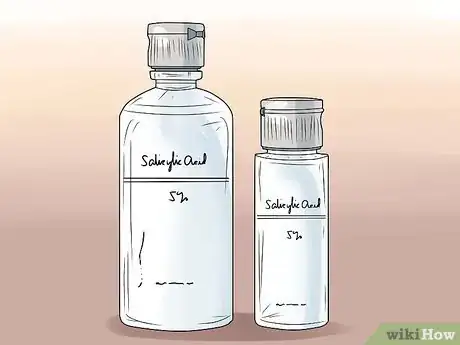
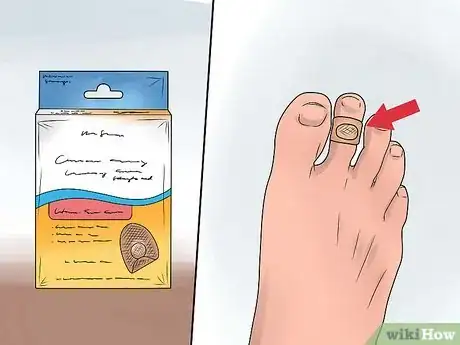
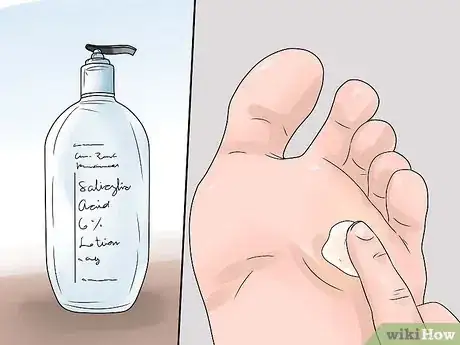
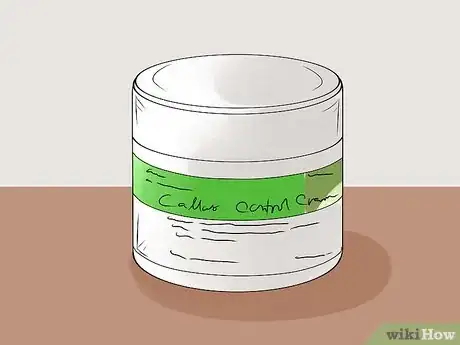
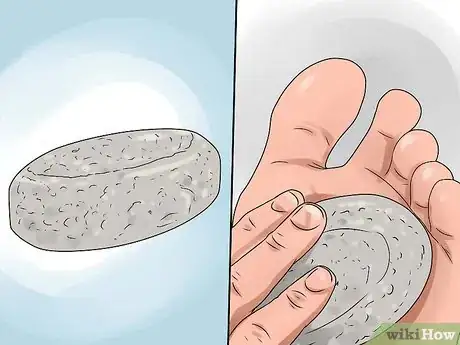

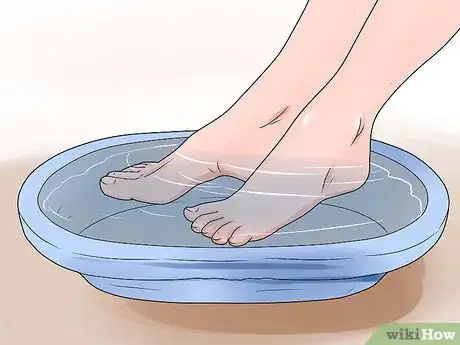
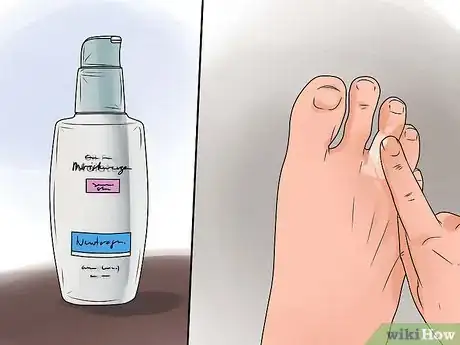
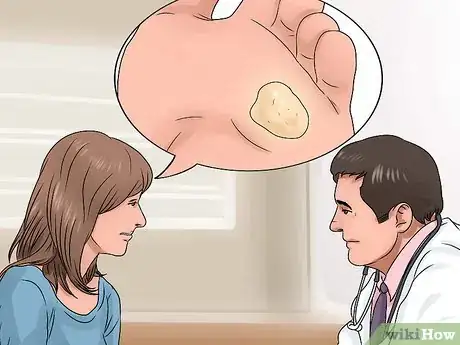
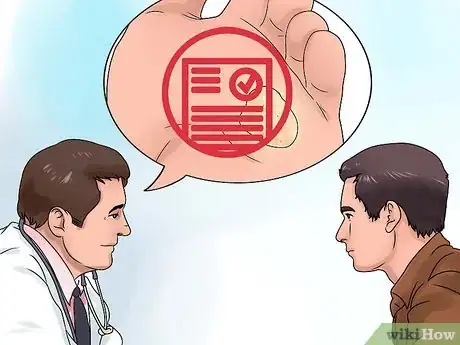
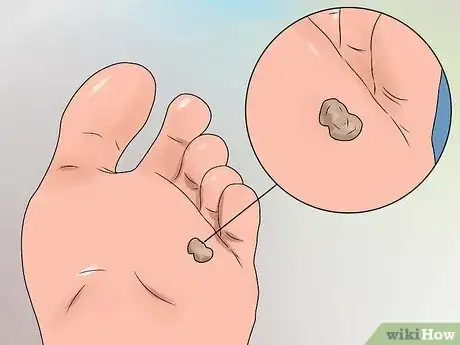
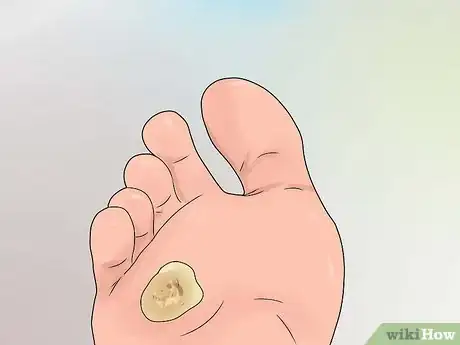

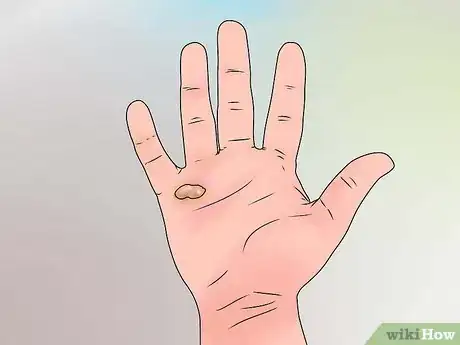
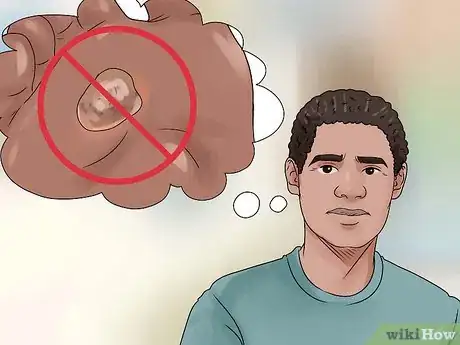
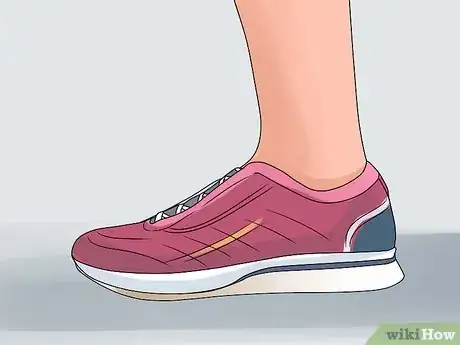
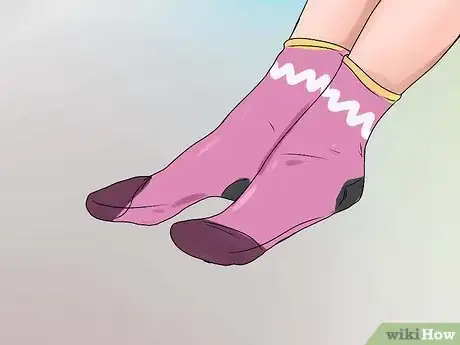
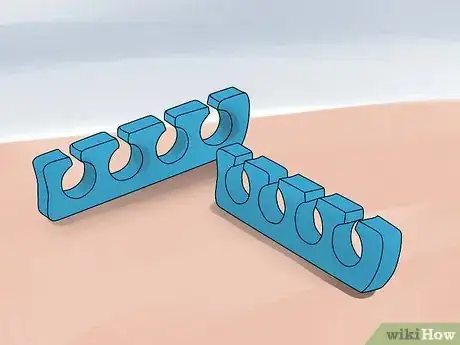
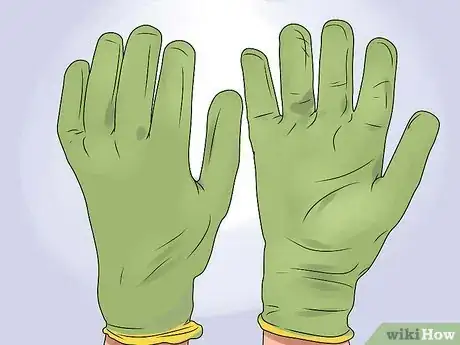
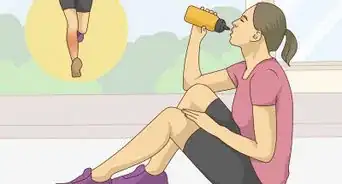
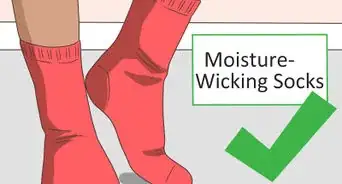


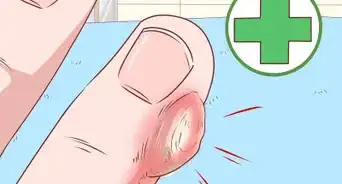
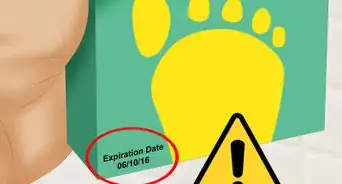
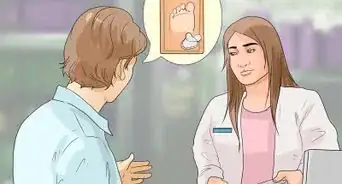
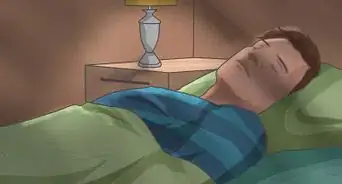
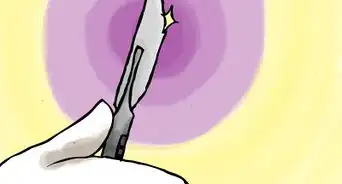
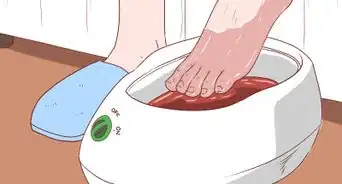
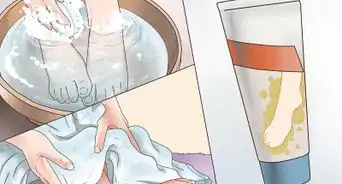
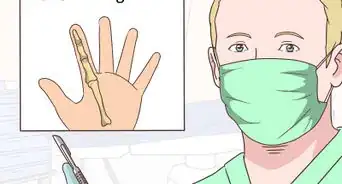
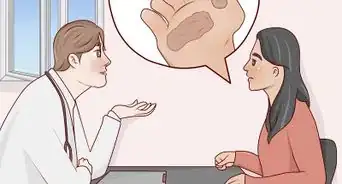
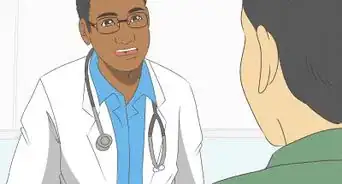









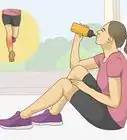


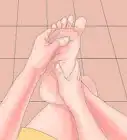



































Medical Disclaimer
The content of this article is not intended to be a substitute for professional medical advice, examination, diagnosis, or treatment. You should always contact your doctor or other qualified healthcare professional before starting, changing, or stopping any kind of health treatment.
Read More...